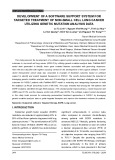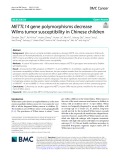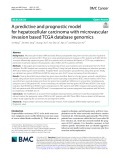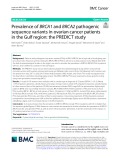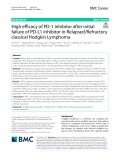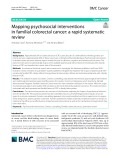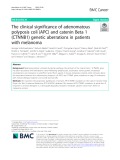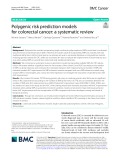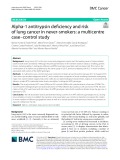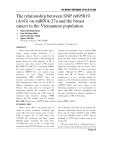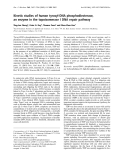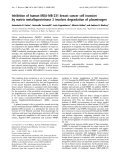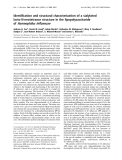
Cancer genetics
-
This study presents the development of a software support system aimed at improving targeted treatment outcomes in non-small cell lung cancer (NSCLC) by utilizing genetic mutation analysis data. PubMed BERT model were generated to identify tumor gene mutated features associated with gene-drug responses.
 14p
14p  vinatisu
vinatisu
 23-08-2024
23-08-2024
 4
4
 1
1
 Download
Download
-
The research project deals with two different types of data for two separate analysis. The first analysis deals with normalised RNA-seq breast cancer data where machine learning techniques are used to classify and identify the biomarker of cancer. Second analysis deals with raw DNA methylated leukemia samples to determine the mutations.
 102p
102p  runthenight04
runthenight04
 02-02-2023
02-02-2023
 5
5
 3
3
 Download
Download
-
Osteosarcoma (OS) is a differentiation disease caused by the genetic and epigenetic differentiation of mesenchymal stem cells into osteoblasts. OS is a common, highly malignant tumor in children and adolescents. Fifteen to 20 % of the patients find distant metastases at their first visit.
 13p
13p  vielonmusk
vielonmusk
 21-01-2022
21-01-2022
 21
21
 0
0
 Download
Download
-
Wilms tumor is a highly heritable malignancy. Aberrant METTL14, a critical component of N6-meth‑ yladenosine (m6 A) methyltransferase, is involved in carcinogenesis. The association between genetic variants in the METTL14 gene and Wilms tumor susceptibility remains to be fully elucidated.
 10p
10p  vielonmusk
vielonmusk
 21-01-2022
21-01-2022
 20
20
 0
0
 Download
Download
-
Microvascular invasion (MVI) adversely affects postoperative long-term survival outcomes in patients with hepatocellular carcinoma (HCC). There is no study addressing genetic changes in HCC patients with MVI.
 11p
11p  vielonmusk
vielonmusk
 21-01-2022
21-01-2022
 22
22
 1
1
 Download
Download
-
Patients with pathogenic sequence variants (PSVs) in BRCA1/BRCA2 are at high risk of developing ovarian cancer (OC). However, genetic testing for BRCA1/BRCA2 PSVs is still not a routine practice in the Middle East. With the lack of epidemiological studies in the region, we aim to describe the prevalence of BRCA1/BRCA2 PSVs in patients with OC across diferent countries in the Gulf region.
 8p
8p  vielonmusk
vielonmusk
 21-01-2022
21-01-2022
 9
9
 1
1
 Download
Download
-
We sought to understand the clinical course and molecular phenotype of patients who showed disease progression after programmed cell death ligand 1 (PD-L1) inhibitor treatment but subsequently responded to PD-1 inhibitor treatment. We also explored the response to PD-1-axis targeted therapy of classical Hodgkin lymphoma (cHL) according to genetically driven PD-L1 and programmed cell death ligand 2 (PD-L2) expression.
 8p
8p  vielonmusk
vielonmusk
 21-01-2022
21-01-2022
 15
15
 1
1
 Download
Download
-
Cancer-related fatigue (CRF) is one of the most common and distressing complaints reported by cancer patients during chemotherapy considerably impacting all aspects of a patient’s life (physical, psychosocial, professional, and socioeconomic).
 11p
11p  vielonmusk
vielonmusk
 21-01-2022
21-01-2022
 13
13
 1
1
 Download
Download
-
Approximately 5% of colorectal cancer (CRC) cases are part of a well-defined inherited genetic syndrome and up to approximately 30% of these cases have a clinically defined familial basis. Psychosocial interventions in familial colorectal cancer address aspects mainly focused on affective, cognitive and behavioural outcomes
 9p
9p  vielonmusk
vielonmusk
 21-01-2022
21-01-2022
 15
15
 0
0
 Download
Download
-
Melanoma-intrinsic activated β-catenin pathway, the product of the catenin beta 1 (CTNNB1) gene, has been associated with low/absent tumor-infiltrating lymphocytes, accelerated tumor growth, metastases development, and resistance to anti-PD-L1/anti-CTLA-4 agents in mouse melanoma models.
 14p
14p  vielonmusk
vielonmusk
 21-01-2022
21-01-2022
 10
10
 0
0
 Download
Download
-
Risk prediction models incorporating single nucleotide polymorphisms (SNPs) could lead to individualized prevention of colorectal cancer (CRC). However, the added value of incorporating SNPs into models with only traditional risk factors is still not clear. Hence, our primary aim was to summarize literature on risk prediction models including genetic variants for CRC, while our secondary aim was to evaluate the improvement of discriminatory accuracy when adding SNPs to a prediction model with only traditional risk factors.
 21p
21p  vielonmusk
vielonmusk
 21-01-2022
21-01-2022
 14
14
 1
1
 Download
Download
-
Microsatellite instability (MSI) is a key marker for predicting the response of immune checkpoint inhibitors (ICIs) and for screening Lynch syndrome (LS). Aim: This study aimed to see the characteristics of cancers with high level of MSI (MSI-H) in genetic medicine and precision medicine.
 12p
12p  vielonmusk
vielonmusk
 21-01-2022
21-01-2022
 10
10
 0
0
 Download
Download
-
Lung cancer (LC) is the most commonly diagnosed cancer and the leading cause of cancer-related death in both sexes worldwide. Although the principal risk factor in the western world is tobacco smoking, genetic factors, including alpha-1 antitrypsin deficiency (AATD), have been associated with increased risk.
 7p
7p  vielonmusk
vielonmusk
 21-01-2022
21-01-2022
 9
9
 1
1
 Download
Download
-
Single-nucleotide polymorphisms (SNP) are common genetic changes in the human genome. In recent time, many scientists have shown their interests in studies on SNPs’ roles in the pathological risk especially in cancer and metabolic diseases.
 27p
27p  tamynhan0
tamynhan0
 15-06-2020
15-06-2020
 18
18
 1
1
 Download
Download
-
Breast cancer (BC), the most common type of cancer among women worldwide, is a polygenetic disease which is caused by the interaction of several genes. Understanding the genetic factors for early diagnosis of BC is crucial to ensure the survival of BC patients. MicroRNA 27a (miR-27a), an oncogenic miRNA, has been predicted to target on the tumor suppressor ZBTB10 that can regulate many processes of cell.
 11p
11p  bautroibinhyen17
bautroibinhyen17
 13-02-2017
13-02-2017
 48
48
 2
2
 Download
Download
-
Khóa luận này đề xuất một mô hình học máy cho bài toán trích chọn sự kiện y sinh phức hợp và áp dụng vào Cancer Genetics (CG) task – một bài toán trích chọn thông tin trong BioNLP Shared Task (ST) 2013.
 53p
53p  mercury2
mercury2
 21-12-2013
21-12-2013
 56
56
 11
11
 Download
Download
-
P-glycoprotein (Pgp), a membrane pump often responsible for the multidrug resistance of cancer cells, undergoes conformational changes in the presence of substrates/modulators, or upon ATP depletion, reflected by its enhanced reactivity with the UIC2 monoclonal antibody. When the UIC2-shift was elicited by certain modulators (e.g. cyclosporin A or vinblastine, but not with verapamil or Tween 80), the subsequent binding of other monoclonal anti-Pgp Ig sharing epitopes with UIC2 (e.g. MM12.10) was abolished [Nagy, H., Goda, K., Arceci, R., Cianfriglia, M., ´ Mechetner, E. & Szabo Jr, G.
 6p
6p  system191
system191
 01-06-2013
01-06-2013
 62
62
 7
7
 Download
Download
-
Tyrosyl-DNA phosphodiesterase (TDP) cleaves the phosphodiester bond linking the active site tyrosine residue of topoisomerase I with the 3¢ terminus of DNA in topoisomerase I–DNA complexes which accumulate during treatment of cancer with camptothecin. In yeast, TDP mutation confers a 1000-fold hypersensitivity to camptothecin in the presence of an additional mutation of RAD9 gene [Pouliot, J.J., Yao, K.C., Robertson, C.A. & Nash, H.A. (1999) Science 286, 552–555].
 8p
8p  research12
research12
 01-06-2013
01-06-2013
 32
32
 2
2
 Download
Download
-
Matrix metalloproteinase (MMP)-3 inhibited human MDA-MB-231 breast cancer cell invasion through recon-stituted basement membranein vitro. Inhibition of invasion was dependent upon plasminogen and MMP-3 activation, was impaired by the peptide MMP-3 inhibitor Ac-Arg-Cys-Gly-Val-Pro-Asp-NH2 and was associated with: rapid MMP-3-mediated plasminogen degradation to microplas-minogen and angiostatin-like fragments;
 8p
8p  research12
research12
 23-04-2013
23-04-2013
 34
34
 3
3
 Download
Download
-
A sialylated lacto-N-neotetraose (Sial-lNnT) structural unit was identified and structurally characterized in the lipo-polysaccharide (LPS) from the genome-sequenced strain Road (RM118) of the human pathogenHaemophilus influ-enzaegrown in the presence of sialic acid. A combination of molecular genetics, MS and NMR spectroscopy techniques showed that this structural unit extended from the proximal heptose residue of the inner core regionof theLPSmolecule.
 11p
11p  research12
research12
 23-04-2013
23-04-2013
 36
36
 2
2
 Download
Download
CHỦ ĐỀ BẠN MUỐN TÌM








